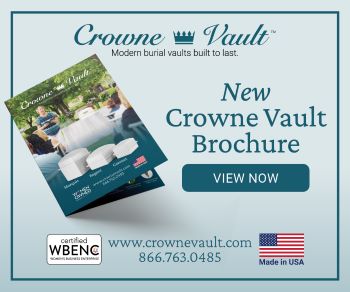The Arrangement and Preneed Conferences
 I’ve been out of active funeral directing for the past eight years. And, I won’t apologize for it, but I’m a traditionalist when it comes to funeral service. That means I still believe in the value of the public acknowledgement of death, the tradition of a service or celebration of life, and the idea of permanent memorialization for the deceased.
I’ve been out of active funeral directing for the past eight years. And, I won’t apologize for it, but I’m a traditionalist when it comes to funeral service. That means I still believe in the value of the public acknowledgement of death, the tradition of a service or celebration of life, and the idea of permanent memorialization for the deceased.
However, every time I turn around I seem to see the public choose services that lack in some of those ingredients. And, I feel kind of bad about that because I truly believe that the elements of the traditional funeral service — acknowledgement, visitation, services, and memorialization — are good for the mental health of those who are left behind.
I’ve lost a father as a teenager, a younger brother to suicide, and my mother to old age. All of those losses hurt. . . all of them stung in different ways, but the common theme about them for me is that as a survivor I was able to come to grips with the deaths in my own time and way. And, the death care choices made by my family – including viewing, the visitation, the service, and the burial in a local cemetery where I can go to visit with them or remember their lives — has led, in part, to my mental well-being.
Now, families are entitled to their own way of grieving and their own choices of celebration and memorialization. But, sometimes I wonder if we always give them all of the options that we have available to set them on the right course for optimum well-being.
Even, when I was working, the family that called and said, “We want grandpa cremated” usually meant direct cremation with a possible memorial service. Almost never did they say those words and envision a casketed visitation and funeral followed by cremation. When they came to the funeral home for arrangements, we explained that option — partly out of simply explaining, but also partly out of trying to raise the ticket price. I’m guessing we converted, maybe 3% to go for that option. . . in any event, it was not a very good conversion rate.
I wonder now if we did things wrong. . . .and if doing it better not only would lead to higher tickets and margins, but to better family satisfaction and well-being as well. Most families have a pretty good idea of what they want. . . . but don’t know all the options. It’s the same for me when buying a car. . . . I had to learn that an auto lease for three years doesn’t bind you to three years. . . .sometimes you can profit by turning the car back in early or you can buy out the lease and own the car early. It’s not complicated, but I don’t work in the auto arena where those types of options are every day items. It’s the same with consumers and your funeral home.
I had my modus operandi when I made preneed or at-need funeral arrangements. I got the information I needed and the desires from the family, but maybe by being more “intentional” in the process I might have opened up options to them they had not even known or thought about and at the same time brought in revenue for the funeral home. Serving my clients better and being more profitable would seem to be a win-win situation for all concerned.
Here’s how I might be more intentional about the arrangements with a family if I went back to the arrangement room:
Method of Disposition — This would be the first item of business just as it always was. Most of the time you are going to know the preferred method of disposition at the removal or with an initial phone call with the family. It’s when they tell you “We want grandpa cremated” or “We’re planning a funeral at ABC Church and burial in Sunset Cemetery. It’s when you can initially get approval for embalming or you can plant a seed about cremation after traditional services. In general, families will choose between traditional earth burial, cremation with memorial services, direct cremation with no services, or alkaline hydrolysis.
Method of Disposition is the first piece of knowledge that the funeral director needs to know and that will lead into my other three areas of “Intentionality” decisions by the family. Those decisions, which I believe help in grief relief include acknowledgement of the death, celebration or recognition of the life lived, and permanent memorialization.
Acknowledgement — I think it is important that acknowledgement of a death is the first step towards survivor recovery. I distinctly remember how hard this was for me shortly after my father’s death. When I went to college and was asked what my parents’ do, I would answer, “We own a funeral home”. It was just difficult for me to admit my circumstances and say something like this, “My father died, but we are operating the funeral home he owned.” I eventually had to get passed that point.
So, if I were making arrangements today, I would first ask the family “How do you want to acknowledge grandpa’s death?” Certain communities have general and customary ways to do this, however, in today’s world I would discuss the idea of online acknowledgement also with the idea of making sure that the announcement and obituary had a wide-ranging sphere such as being placed on Legacy.com or some other similar medium.
Celebration or Recognition of a Life Lived – My next intentional act of the conference would be to discuss the idea of some type of centralized gathering for those that would like to pay their respects or visit with the family. It’s also a place where memorabilia may be gathered to form a “Life Remembrance” of the deceased. In the form of a traditional funeral/burial this is done at the visitation and, sometimes, again at the place of the funeral.

Tom Anderson
Funeral Director Daily
I think, however, if funeral homes can be flexible, we have the ability to give this option to cremation families who don’t necessarily want visitations or memorial services. Funeral homes have to know their community and be creative. Our community has had several golf club members who have chosen direct cremation with no services. However, I’ve been to several “Receptions” at the golf club’s banquet hall to pay my respects.
Families need to understand that this can be done without formal services. . . a gathering where friends can pay respects can serve the purpose. For families that don’t want to use a funeral home, your staff needs to know about the hotel banquet rooms, the golf club rooms, the union halls, and other locations. And, you need to know your caterers. What about that avid pilot who has died and been cremated. . . .have you thought about a reception gathering at an airport hangar surrounded with planes. Or the youth hockey coach, how about the local ice arena with open skating available?
Think about this the same way that families celebrate graduations, confirmations, or wedding anniversaries. Regardless of where this event is held, I believe it is good for grief relief and can also bring in revenue for the funeral home by staffing the situation.
Permanent Memorialization — As I mentioned earlier, I’m a big believer in permanent memorialization. It’s pretty simple in a traditional casketed earth burial. The concept itself leads into earth burial with a monument. But, what about the growing trend of cremation, alkaline hydrolysis, and/or recomposition (human composting). All of those methods leave remains that many families have not thought about the idea of permanent memorialization for.
Permanent memorialization is all about “Place” and “History”.
And, while I’m for cemetery permanent memorialization with a marker, I’ve changed my tune about other ideas as well. For instance, Better Place Forests allows permanent memorialization with a tree as a monument. That’s okay too. It is place and, if we know who is there, it can lead to history.
But, what about all the families who simply want an urn and don’t know what they will be doing with it. . . or those who mention that they will be scattering the ashes? I’ve been with enough families who regretted scattering ashes that I was never uncomfortable mentioning to them that they could scatter some cremains while still holding on to some that they could bury in a cemetery or place in a columbarium — providing place and history. Then, there is always someone in the family who asks about cremation jewelry or other cremation items.
So, I think it is really important to go through all of the potential ideas for permanent memorialization with families. . . .those include the obvious like burial or niche placement, but should also include options like Better Place Forests, cremation jewelry and solidified remains options like Parting Stone.
Finally, in addition to whatever physical permanent memorialization may be selected I think it is important to give “cyber” options for permanent memorialization as well. Options like Eppilog, where one can post an obituary that can be a living and changing document of one’s history. In a new world sense, these cyber memorials can bring “Place” to grieving families as they are able to “go” to the website at any time and reflect much like I reflect at the physical graves of my father, mother, and brother.
In my opinion, all of these “Permanent Memorialization” ideas will, in the long run create better grief recovery for families and, at the same time, may bring much needed ancillary income to funeral homes.
As death care moves forward the intentionality that we have with the families that we serve may make all the difference in how they recover from their loss and how funeral homes improve their balance sheet as well.
More news from the world of Death Care:
- Sen. Bob Dole laid to rest at Arlington National Cemetery with full military honors. Video and print article. Military.com
- College student gets stranger’s cremated remains instead of Apple charger. News Channel 8 – Tampa (FL)
- West Side funeral home gutted by fire. Local 12 – WKRC Cincinnati (OH)
Enter your e-mail below to join the 2,535 others who receive Funeral Director Daily articles daily:





















